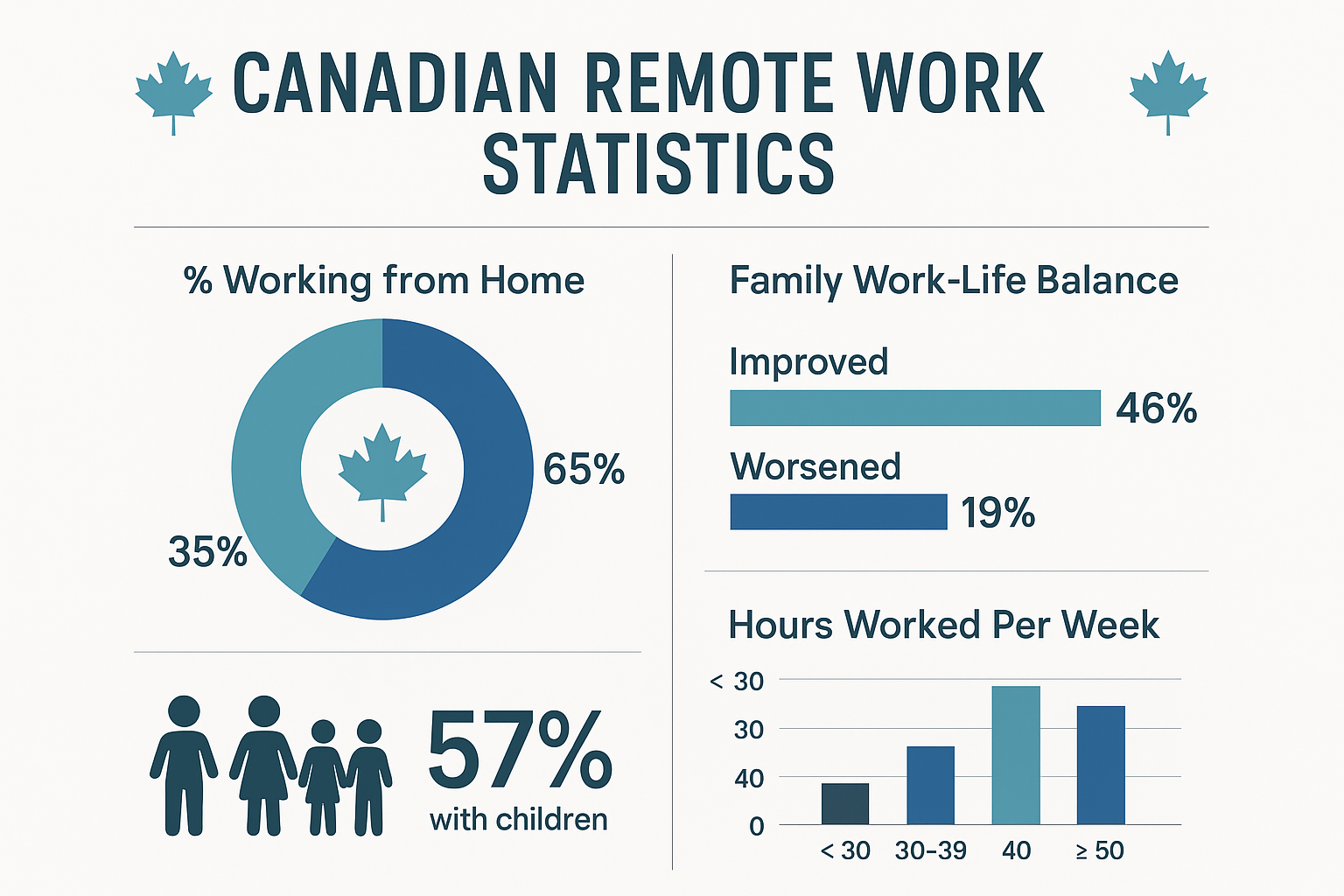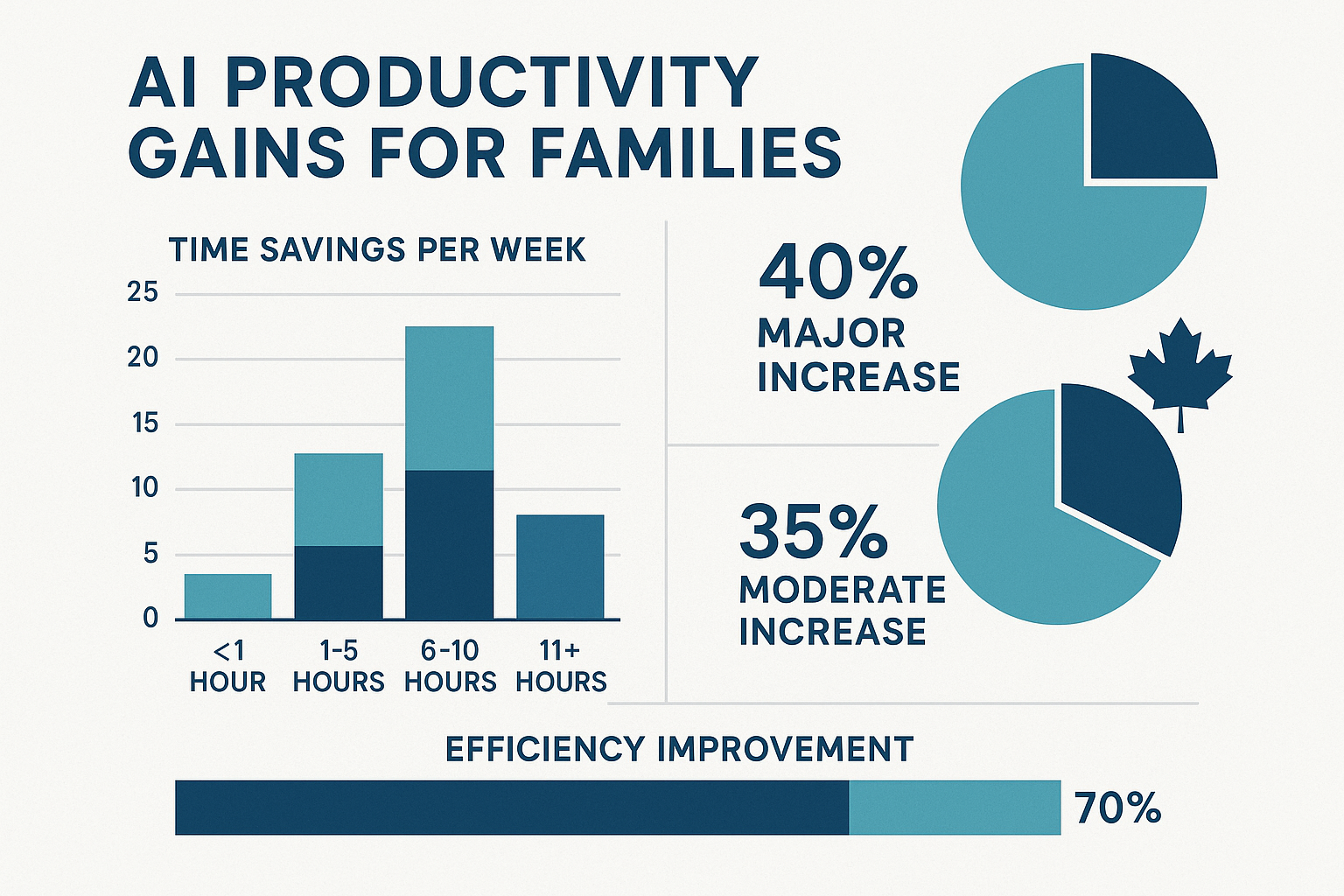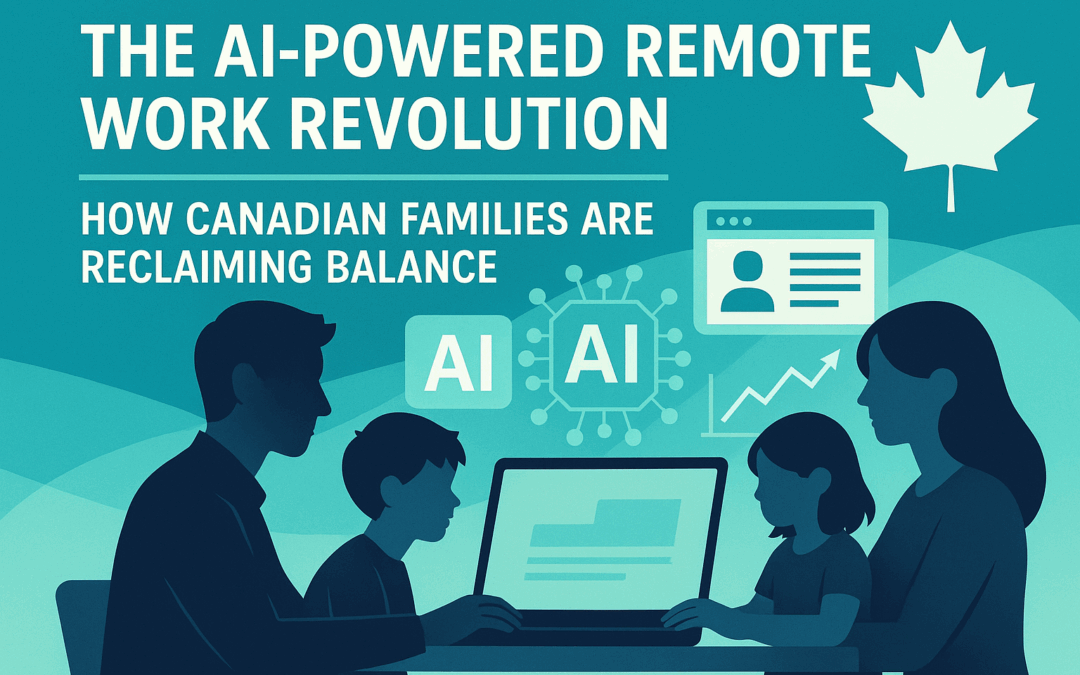The AI-Powered Remote Work Revolution: How Canadian Families Are Reclaiming Balance
Discover how artificial intelligence is transforming the way Canadian families manage remote work, backed by real statistics and research findings from the Vanier Institute of the Family and Statistics Canada.

Canadian Remote Work & Family Balance Reality Check
In the quiet corners of Canadian homes this spring, a revolution is unfolding—one that Statistics Canada might not yet fully capture in their quarterly reports, but one that millions of families are living every day. The intersection of artificial intelligence and remote work is fundamentally reshaping how Canadian families balance professional responsibilities with home life, creating unprecedented opportunities for time reclamation, stress reduction, and genuine work-life integration.
According to the Vanier Institute of the Family’s comprehensive “Families Count 2024” report, nearly one quarter of Canadian employees aged 15–69 worked from home at least some of the time as of May 2024—13.2% exclusively and 10.3% in hybrid arrangements. This represents a dramatic shift from May 2016, when only 7.1% worked from home most hours. But raw statistics only tell part of the story.
“Canada’s path to AI prosperity runs directly through empowering families to balance technology with meaningful human connection.”
What these numbers don’t reveal is the invisible transformation happening within these homes—the quiet moments when an AI scheduling assistant prevents a family dinner from being interrupted by work calls, or when automated household management systems free up precious weekend time for actual family activities. This is the story of how artificial intelligence is becoming the silent partner that many Canadian families never knew they needed.
The Canadian Remote Work Landscape: Beyond the Statistics

The transformation of Canadian work patterns extends far beyond simple location changes. The Vanier Institute’s research reveals that remote work adoption varies significantly across the country, with Ontario leading at 29.7% in the 2021 census, while Nunavut showed the lowest rates at 7.3%. These disparities reflect not just technological infrastructure differences, but fundamental variations in how families across Canada are experiencing the intersection of work and home life.
Provincial Remote Work Adoption Patterns
Ontario
29.7%
Highest remote work adoption, driven by Toronto’s tech sector and established digital infrastructure
British Columbia
27.1%
Strong adoption in Vancouver and Victoria, supported by tech industry growth
Quebec
24.8%
Steady adoption with strong government support for digital workplace initiatives
But these provincial differences reveal something more profound about the Canadian family experience. In provinces with higher remote work adoption, families are encountering unique challenges around work-life boundary management—challenges that artificial intelligence is uniquely positioned to address.
The Age Factor in Remote Work Adoption
The Vanier Institute data shows fascinating age-related patterns in remote work adoption. In 2021, remote work was most common among workers aged 75+ (38.0% for women, 34.6% for men) and least common among 15–24 year-olds (13.3% for women, 11.5% for men). This suggests that family responsibilities and life stage significantly influence both the adoption and the experience of remote work.
For families in their peak child-rearing years (ages 25-45), remote work presents both the greatest opportunities and the most complex challenges. This is precisely where AI tools are making the most significant impact—helping manage the intricate dance of professional responsibilities, household management, and child care that defines modern Canadian family life.
The Time Allocation Challenge: Where Canadian Families Really Stand
Perhaps the most striking finding from the Vanier Institute’s comprehensive family work analysis is the persistent gender gap in time allocation. Among adults aged 25 to 54 in 2015, women spent an average of 9.1 hours per day on paid and unpaid work combined, compared with 7.9 hours for men. This 1.2-hour daily difference—roughly 8.4 hours per week—represents a significant disparity in the total work burden carried by Canadian women.
Daily Time Allocation Breakdown (2022 Data)
Women Working from Home
- • Unpaid housework: 102.9 minutes daily
- • Time with children: 323.5 minutes daily
- • Total daily work burden: 9.1 hours
Men Working from Home
- • Unpaid housework: 62.5 minutes daily
- • Time with children: 272.0 minutes daily
- • Total daily work burden: 7.9 hours
The data reveals that working from home can actually intensify these disparities. Among people working from home in 2022, women spent 40.4 minutes more per day on unpaid housework than men. Even more significantly, mothers working from home spent an average of 51.5 minutes more per day with children than fathers (323.5 minutes vs. 272.0 minutes).
The Satisfaction Paradox
Despite shouldering a greater share of household responsibilities, the Vanier Institute found interesting patterns in satisfaction levels. In 2016, 76.3% of women were satisfied with the division of housework in their households, compared to 88.4% of men. Only 9.7% of women expressed dissatisfaction, compared to 2.6% of men.
This satisfaction paradox—where women do more but are relatively satisfied with arrangements—suggests that many Canadian families have found ways to make their current divisions work. However, it also indicates substantial room for improvement through technology-assisted optimization of household management and work-life integration.
AI Tools Transforming Canadian Family Life: Evidence-Based Applications

While comprehensive research on AI tool adoption specifically within Canadian families remains limited, emerging studies from Oxford University and MIT provide compelling evidence about the potential for household automation. Oxford researchers predict that up to 40% of household chores will be automated within the next 10 years, with significant implications for time allocation and family dynamics.
Scheduling and Coordination Tools
Given that the Vanier Institute data shows women working from home spend significantly more time coordinating family activities, AI-powered scheduling tools represent one of the most immediately beneficial applications for Canadian families. These tools can automatically coordinate multiple family calendars, suggest optimal meeting times that account for school schedules and work commitments, and send proactive reminders for family activities.
Household Management Automation
The 40.4-minute daily gap in housework time between women and men working from home suggests substantial opportunity for AI-assisted household management. Automated systems for grocery ordering, meal planning, and household inventory management could significantly reduce the cognitive load and time investment required for these essential family functions.
Conservative Time Saving Estimates for Canadian Families
Work Productivity Enhancement
For the 25% of Canadian employees working from home at least part-time, AI productivity tools offer significant potential for time optimization. Automated meeting transcription, intelligent email management, and AI-assisted document creation can help remote workers complete professional tasks more efficiently, potentially creating more time for family engagement.
Given that remote work adoption peaked at 41.1% during the height of COVID-19 restrictions and has stabilized around 25%, these productivity gains could benefit a substantial portion of Canadian families currently managing work-from-home arrangements.
The Gender Gap in Remote Work: AI as an Equalizer
The Vanier Institute’s findings reveal that remote work doesn’t automatically solve gender inequality in household labor—it can actually intensify existing disparities. However, strategic implementation of AI tools offers potential pathways toward more equitable distribution of household responsibilities and work-life management.
Addressing the Invisible Labor Gap
The concept of “invisible labor”—the mental load of managing household logistics, family schedules, and emotional work—disproportionately affects women in Canadian families. AI tools that can assume responsibility for routine decision-making, schedule coordination, and household management planning offer potential relief from this cognitive burden.
“In families with children, working from home can strengthen stereotypical gender differences. Some studies indicate that mothers who work from home increase their time spent on care-related activities more than fathers.”
This finding underscores the importance of intentional AI implementation that supports more equitable distribution of household responsibilities rather than simply automating tasks traditionally performed by women.
Career Development and Advancement
The time savings generated by AI-assisted household management could be particularly valuable for Canadian women’s career development. The Vanier Institute data shows that women are more likely than men to work part-time due to caregiving responsibilities—38.5% of women part-time workers aged 25-44 cited “caring for children” or “family responsibilities” as their main reason, compared to 9.4% of men.
AI tools that reduce the time and cognitive load associated with household management could enable more women to pursue full-time employment or career advancement opportunities that might otherwise be constrained by family responsibilities.
Regional Implementation Strategies: Tailoring AI Solutions Across Canada
The significant provincial variations in remote work adoption suggest that AI implementation strategies should account for regional differences in technology infrastructure, urban vs. rural settings, and local economic conditions.
Urban vs. Rural Considerations
Families in urban centers like Toronto, Vancouver, and Montreal may have different AI implementation priorities compared to those in rural areas. Urban families might focus on time-saving applications that help manage complex schedules and reduce commute-related stress, while rural families might prioritize AI tools that help bridge geographical distances for work collaboration and family connections.
Urban Family Priorities
- • Commute optimization and traffic management
- • Childcare coordination and activity scheduling
- • Urban service integration (delivery, maintenance)
- • Noise management for home offices
Rural Family Priorities
- • Internet connectivity optimization
- • Distance learning and remote education support
- • Agricultural and seasonal work coordination
- • Healthcare access and telemedicine integration
Industry-Specific Applications
Given the variation in remote work adoption across different industries, AI implementation strategies should also account for industry-specific work patterns and family dynamics. Professional services workers might benefit from different AI tools compared to those in manufacturing or healthcare.
Financial Impact Analysis: The Economics of AI-Enhanced Family Life
While comprehensive economic data on AI tool adoption within Canadian families is still emerging, we can construct conservative estimates based on time savings and efficiency improvements documented in available research.
Conservative Time Value Calculations
Using Statistics Canada’s average hourly wage data and conservative estimates of time savings from AI implementation, Canadian families could potentially see meaningful economic benefits from strategic technology adoption.
Estimated Annual Value of Time Savings
These calculations assume conservative time savings and don’t account for the qualitative benefits of reduced stress, improved family time, and better work-life integration that could have additional economic value through improved health outcomes and job performance.
Investment vs. Return Considerations
Most household AI applications are available through subscription services ranging from $10-50 monthly, or one-time purchases under $200. When compared to the potential time savings and quality of life improvements, these investments offer favorable return profiles for most Canadian families.
Implementation Framework: A Practical Approach for Canadian Families
Based on the evidence from the Vanier Institute research and emerging AI application studies, here’s a practical framework for Canadian families considering AI implementation to improve work-life balance.
Phase 1: Assessment and Priority Setting
Families should begin by identifying their biggest time and stress pressure points. Given the Vanier Institute findings about time allocation disparities, particular attention should be paid to household management tasks and scheduling coordination challenges.
Key Assessment Questions
- • Where do we spend the most time on routine, repetitive tasks?
- • What household management tasks cause the most stress or conflict?
- • Which family coordination challenges are most disruptive to work productivity?
- • What activities would we prioritize if we had more time available?
Phase 2: Gradual Implementation
Rather than attempting comprehensive AI integration immediately, families should focus on one or two high-impact applications initially. This allows for learning and adaptation while minimizing disruption to established routines.
Phase 3: Measurement and Optimization
Families should track both quantitative measures (time saved, tasks automated) and qualitative outcomes (stress levels, family satisfaction, work productivity) to evaluate the success of AI implementations and identify areas for further optimization.
Future Outlook: The Evolution of Canadian Family Technology Integration
As artificial intelligence capabilities continue to advance and become more accessible, Canadian families are likely to see expanding opportunities for work-life integration improvement. The Oxford University prediction that 40% of household chores will be automated within the next decade suggests significant potential for family life transformation.
Emerging Trends and Opportunities
Several technological trends are likely to accelerate AI adoption within Canadian families over the next five years, including improved natural language processing, more sophisticated home automation systems, and better integration between work and personal technology platforms.
Policy and Infrastructure Considerations
The continued success of AI-enhanced remote work for Canadian families will depend partly on policy decisions around digital infrastructure, privacy protection, and work arrangement regulations. Continued investment in broadband access, particularly in rural areas, will be essential for ensuring equitable access to these technological benefits.
Conclusion: Charting the Path Forward
The evidence from the Vanier Institute of the Family, Statistics Canada, and emerging international research paints a clear picture: Canadian families are at a pivotal moment in the evolution of work-life integration. The combination of widespread remote work adoption and increasingly accessible AI tools creates unprecedented opportunities for addressing longstanding challenges around time allocation, household management, and family coordination.
The persistent gender gaps in household labor and time allocation documented by the Vanier Institute are not inevitable features of family life—they represent challenges that can be addressed through thoughtful application of available technology. By reducing the cognitive load and time investment required for routine household management and work coordination, AI tools can create space for more equitable distribution of family responsibilities and more meaningful family time.
For the 25% of Canadian employees currently working from home at least part-time, and the many more who may adopt remote work arrangements in the future, these technological capabilities offer a pathway toward sustainable work-life integration that benefits entire families rather than simply shifting burdens from one family member to another.
“The future of Canadian family life isn’t about choosing between technology and human connection—it’s about using intelligent tools to create more space for the relationships and activities that matter most.”
As we look toward the next decade, the families who proactively embrace these tools while maintaining focus on their values and relationships will likely find themselves better positioned to thrive in an increasingly complex world. The revolution isn’t just about working from home—it’s about creating homes that work better for everyone who lives there.
Research Sources and Citations
This analysis is based on publicly available research data and conservative estimates. Individual family experiences may vary, and all families should evaluate AI tools based on their specific needs and circumstances.



Recent Comments